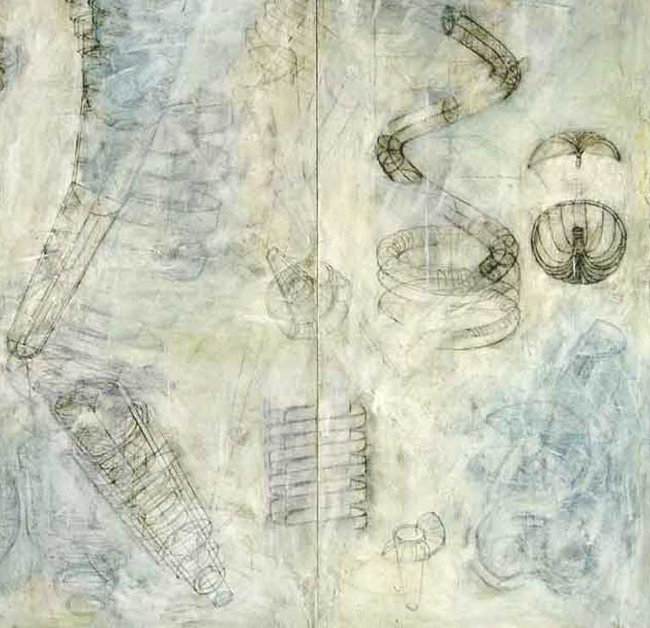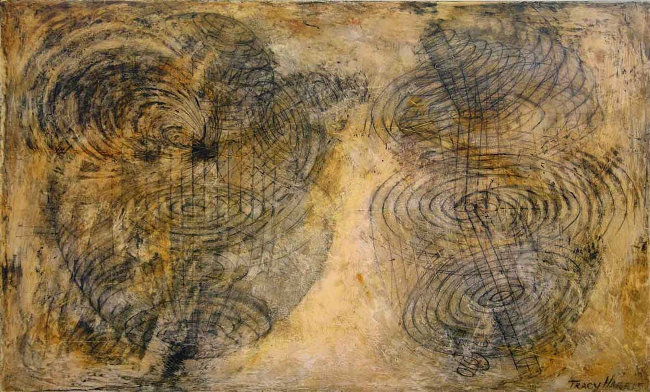
Tracy Harris, Funnel Made of Wind or Water (detail), oil, wax, graphite on wood, 80 x 108 inches
link to artist's website
At the time I wrote the review below I was covering Texas for Artforum. I had every intention of submitting it to the magazine but didn't. Looking back the writing seems fine so I don't know what I was thinking. I remember an acquaintance (or perhaps another review) saying the work had a "da Vinci's notebooks" vibe and it sort of does but I saw the ideas as more contemporary. The images here come from Harris' website -- they are closest to what I remember of her work in the show.
Tracy Harris
Graham Gallery, Houston, TX
June 8 - July 9, 1991
Abstract painting lends itself to the exploration of ideas suggested by contemporary physics: the interrelatedness of things, the unraveling of cause and effect, the impact of the observer on the observed. Tracy Harris fuses concepts of 20th Century art and science in a quite literal way, by incorporating scientific imagery into the chaotic vocabulary of Abstract Expressionism. On wooden panels, heavily-textured fields of blue-green and beige serve as backgrounds for line drawings suggesting the cryptic notations of engineers, physicists, and industrial designers. Although the schematics hint at specific activities -- plotting black hole coordinates, designing a better teacup -- they seem just as concerned with the roles of choice and chance in the creation of works of art.
Harris pays equal attention to the rendering of figures (predominantly cones, spirals, funnels, and cylinders, varying in size and depth) and the negative spaces surrounding them -- voids of muted color that alternately swirl with gestural life or lapse into states of graceful decay. She restlessly draws, erases, and redraws the figures, leaving ghostly traces as if on palimpsests, and scrapes and scumbles the backgrounds until they attain a comparable degree of surface complexity. Occasionally figures and grounds unite synergistically, as in one untitled panel suggesting a series of mechanical arms spiraling down a cosmic drain, and another in which bowl-shapes progress through stages of Cubistic dismemberment.
It would be tempting to discuss Harris' work purely in formal terms; obviously line quality, balance, and texture are important to the artist, and the images record her struggles to bring these elements to a state of eccentric perfection. Some viewers may see the schematic drawings as abstract motifs or design elements and leave it at that. One writer has called them "iconic," disregarding the patterns of uncertainty and choice implied by the webs of half-erased lines surrounding or connecting objects. It would certainly be farfetched to interpret the panels as Dadaist jeremiads on the mechanization of sex or the dehumanizing effects of technology.
If the diagrammatic shapes were just motifs or static icons, the paintings wouldn't be as compelling as they are. Part of their fascination lies in the success of the artist's research -- her knack for finding utilitarian images that work well as components in imaginative hybrids. In this sense, the shapes become metaphors for the process of invention. Paradoxically, in the course of the artist's self-imposed struggles with the formal aspects of the work, something very unscientific occurs: she invests the shapes with emotional life, making it possible to see them as characters in peculiar contemporary dramas. Chaos theory and the riddles of quantum mechanics obviously figure in these productions; the extent to which they act as plot or scenery is a question bearing further study.

Tracy Harris, Warp and Weft, oil and wax on wood, 34 x 56 inches
link to artist's website
[italicized introduction edited after posting]
